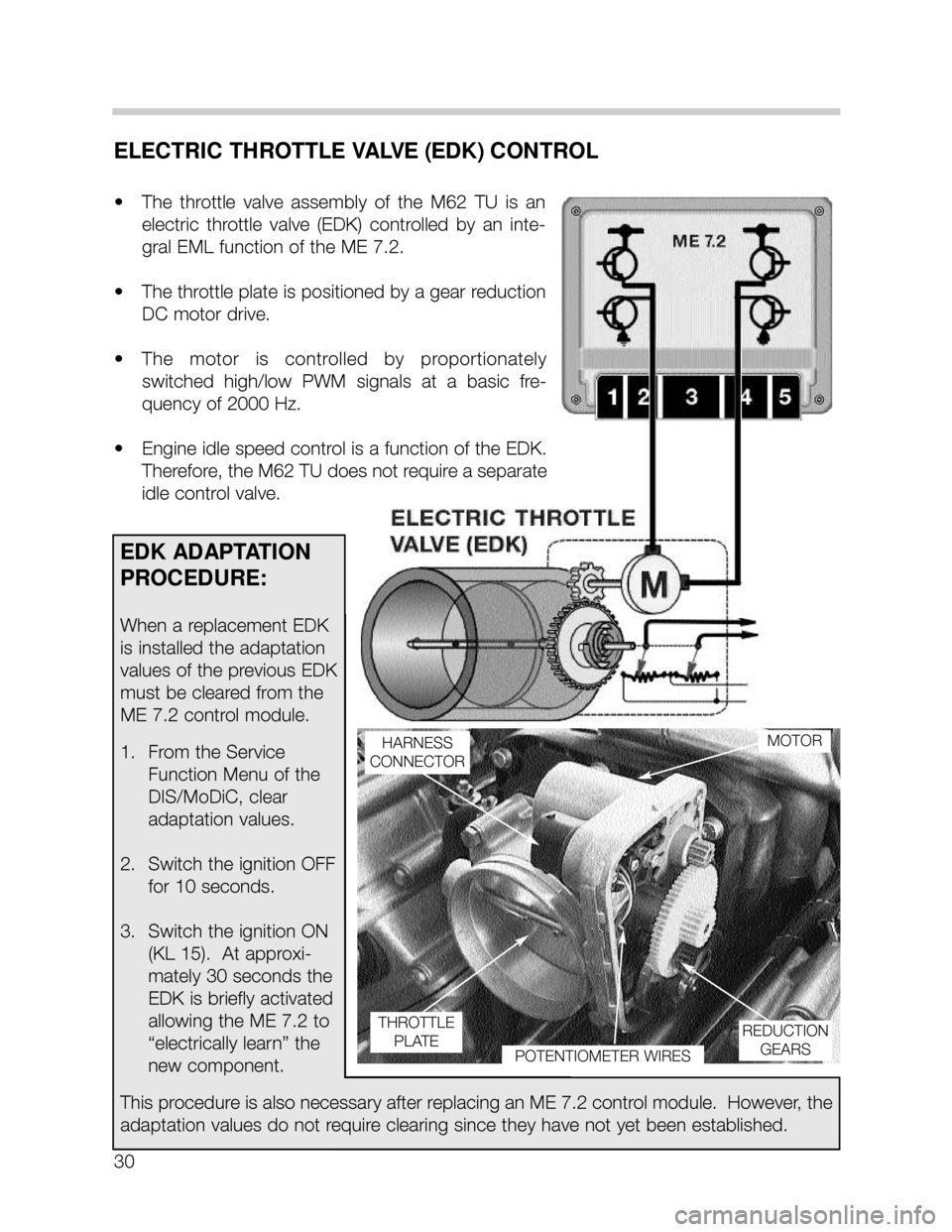Page 27 of 37
27
OUTPUT CONTROL FUNCTIONS
FUEL PUMP RELAY CONTROL
ME 7.2 controls the fuel pump relay as with previous systems with regard to engine speed
input for continual activation of the relay.
The ME 7.2 will switch off the fuel pump relay when an airbag is activated as an addition-
al safety function. The signal is passed from the MRS III control module to the ME 7.2 over
the CAN line
E BOX FAN CONTROL
The E Box fan is controlled by ME 7.2. The control module
contains an integral NTC temperature sensor for the pur-
pose of monitoring the E box temperature and activating the
fan.
When the temperature in the E-Box exceeds predetermined
values, ME 7.2 provides a switched ground for the E Box fan
to cool the E box located control modules.
With every engine start-up, ME 7.2 briefly activates the fan
ensuring continued fan motor operation for the service life of
the vehicle. This feature is intended to prevent fan motor
“lock up” from lack of use due to pitting or corrosion over
time.
Page 30 of 37

30
ELECTRIC THROTTLE VALVE (EDK) CONTROL
• The throttle valve assembly of the M62 TU is an
electric throttle valve (EDK) controlled by an inte-
gral EML function of the ME 7.2.
• The throttle plate is positioned by a gear reduction
DC motor drive.
• The motor is controlled by proportionately
switched high/low PWM signals at a basic fre-
quency of 2000 Hz.
• Engine idle speed control is a function of the EDK.
Therefore, the M62 TU does not require a separate
idle control valve.
HARNESS
CONNECTORMOTOR
REDUCTION
GEARS
POTENTIOMETER WIRES
THROTTLE
PLATE
EDK ADAPTATION
PROCEDURE:
When a replacement EDK
is installed the adaptation
values of the previous EDK
must be cleared from the
ME 7.2 control module.
1. From the Service
Function Menu of the
DIS/MoDiC, clear
adaptation values.
2. Switch the ignition OFF
for 10 seconds.
3. Switch the ignition ON
(KL 15). At approxi-
mately 30 seconds the
EDK is briefly activated
allowing the ME 7.2 to
“electrically learn” the
new component.
This procedure is also necessary after replacing an ME 7.2 control module. However, the
adaptation values do not require clearing since they have not yet been established.
Page 33 of 37
FUNCTION
The DC Motor LDP ensures accurate fuel system leak detection for leaks as small as
0.5mm (.020”). The pump contains an integral DC motor which is activated directly by the
engine control module. The ECM monitors the pump motor operating current as the mea-
surement for detecting leaks.
The pump also contains an ECM controlled change over valve that is energized closed dur-
ing a Leak Diagnosis test. The change over valve is open during all other periods of oper-
ation allowing the fuel system to “breath” through the inlet filter (similar to the full down
stroke of the current vacuum operated LDP).
DC MOTOR LDP INACTIVE -- NORMAL PURGE VALVE OPERATION
In it’s inactive state the pump motor and the change over valve of the DC Motor LDP are
not energized. When purge valve operation occurs filtered air enters the fuel system com-
pensating for engine vacuum drawing on the hydrocarbon vapors stored in the charcoal
canister.
33
Page 34 of 37

LEAK DIAGNOSIS TEST PRECONDITIONS
The DME only initiates a leak diagnosis test every second time the criteria are met. The cri-
teria is as follows:
• Engine OFF with ignition switched OFF.
• Engine Control Module still in active state or what is known as “follow up mode” (Main
Relay energized, control module and DME components online for extended period after
key off).
• Prior to Engine/Ignition switch OFF condition, vehicle must have been driven for a min-
imum of 20 minutes.
• Prior to minimum 20 minute drive, the vehicle must have been OFF for a minimum of 5
hours.
• Fuel Tank Capacity must be between 15 and 85%(safe approximation between 1/4 -
3/4 of a tank).
• Ambient Air Temperature between -7
OC & 35OC(20OF & 95OF )
• Altitude < 2500m(8,202 feet).
• Battery Voltage between 11.5 and 14.5 Volts
When these criteria are satisfied every second time, the ECM will start the Fuel System Leak
Diagnosis Test. The test will typically be carried out once a day i.e. once after driving to
work in the morning, when driving home in the evening, the criteria are once again met but
the test is not initiated. The following morning, the test will run again.
34
Page:
< prev 1-8 9-16 17-24